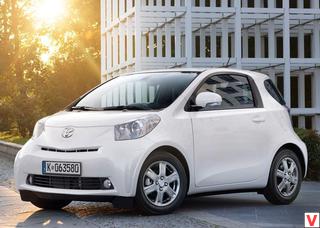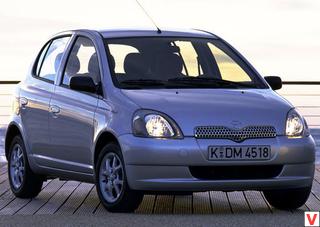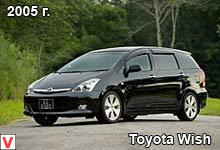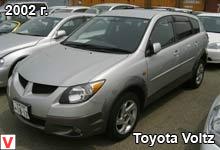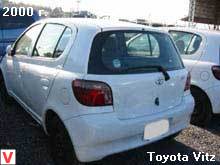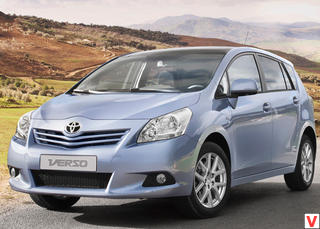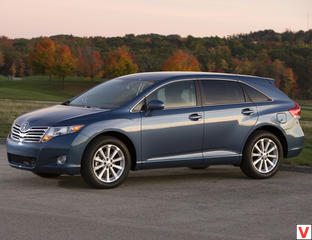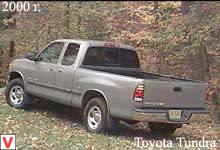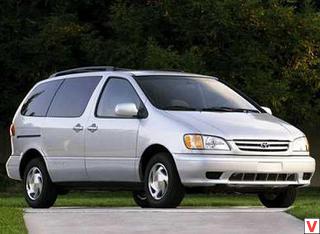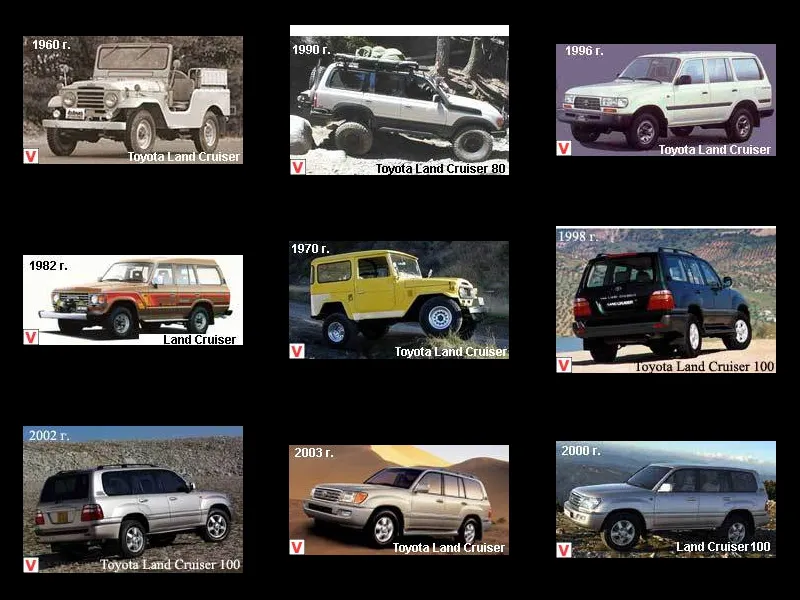
Today, all Land Cruiser models can be divided into series: the 20th, 40th, 60th, 70th, 80th and 100th. The history of the 40th series begins in 1960, when an evolutionary step was taken in the production of cars. Production technologies have been modernized and automotive processes such as panel assembly have been modified.
A reduction series was added to the transmission, which significantly improved the performance of the vehicle under heavy loads and in off-road conditions. The transfer case control shift lever was moved closer to the instrument panel, and the gear shift lever was placed on the steering column, which freed up space on the floor. As a result, in the front seat could accommodate three passengers. While the engine power of type B in cars of the 20th series was 105 hp, the engine of the car of the 40th series already had a power of 125 hp, which was subsequently increased to 130 hp.

In the rear glazing, windows in the corners were added - this increased the rear visibility and became the hallmark of the 40 Series Land Cruiser cars. In 1974, cars with a diesel engine of type B first appeared, and the engine capacity was increased from 2.8 liters to three liters. They fell into the category of compact cars, and this markedly reduced the cost of maintenance and tax for car owners.
Accordingly, the number of people who could afford to keep such an SUV increased. Cars of the 40th series were sold for about 24 years, until they were replaced by new models of the 70th series. The appearance did not change much, but the filling was constantly improved. SUVs of the 40th series have not been produced for a long time, so you most likely will not find them in good condition for sale, but “drove” the car on the go - easily.
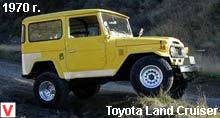
In 1976, under the leadership of Chief Engineer Hiroshi Osawa, the development of Toyot's 60th series, which will be released in 1980, begins. This series of configuration is very similar to the 40th, the same fully dependent spring suspension, and in the first versions there were even identical engines and gearboxes. But the changes were still there, so in 1982 a HJ60 car appeared with a six-cylinder diesel engine of type 2H of 3980 cm3. A volumetric engine, a high-roofed body, a five-speed manual gearbox or a four-stage automatic transmission, an electric sunroof, and mirrors with remote control made the car powerful and, at the same time, comfortable.
In 1987, small changes were made in the appearance of the 60 Series: two round headlights changed to 4 square, wider tires were installed, as well as a colorful body design. The 60th series is a vivid example of how a Land Cruiser turned into a comfortable passenger car from a semi-military vehicle. This model became the prototype for the subsequent development of the models of the 80th and 100th series. In November 1984, a new 70th series appeared, which completed an entire era, which, starting with the models of the 20th series, lasted for 29 years, and during which the 40th series did not change in principle.

Toyota started developing new Land Cruisers, which included the legendary strength and endurance of previous brands, along with the newfangled technologies of modern models. Therefore, the solution was to use a well-proven design with a ladder-type frame and suspension on semi-elliptical springs. Also the thickness of the body panels was increased by 1 mm. In the production range, there were 2 modifications of cars - a short-base (BJ70) with an all-metal body and a canvas top, and a midbase (BJ73) with a removable plastic top.
In January 1990, for the models of the 70th series, two new engines appeared: the gasoline 1PZ, replacing the type 3B engine (OHC five-cylinder, 3469 cm3, 115hp, 23.5 kgm), and the diesel engine 1NZ, replacing 13B-T (OHC six-cylinder, 4163 cm3, 135 hp, 28.5 kgm). In the cars of the 40th and 50th series, the riveting method was used as the main method of joining the main elements of the base frame, while the parts of the LandCruiser 70 frame were connected using laser help, which made the car more durable. Thanks to the efforts of Toyota specialists, Land Cruiser models were constantly upgraded. The changes concerned the engines, suspension, interior equipment.
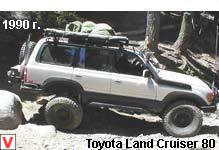
However, in the early Land Cruiser models, driving performance and reliability have never been sacrificed for design refinement and comfort. But the reality is that for the past 15 years, the Land Cruiser’s main buyer has been a city dweller, and he is more often exploiting his car on ideal roads than on off-road tracks. Due to these circumstances, comfort is now coming to the fore for designers and engineers, because along with high traffic, the buyer wants to get climate control, leather upholstery and other wonders of technical progress.
Therefore, already in October 1989, a new generation of the Toyotas Land Cruiser 80 debuted on the market. This series differed from its predecessors by a somewhat more rounded contours, increased rigidity of the frame and body and, of course, "stuffing." The buyer could choose one of three modifications - from the simplest “STD” to the prestigious “VX”. "Toyota Land Cruiser 80 - STD" because of its simplicity and reliability in many countries was used as an army jeep. In this model there is a minimum of electronics, there is no ABS dirt that is afraid. As an additional option, it was proposed to install a mechanical winch with a maximum force of 4 tons, indispensable when driving off-road.
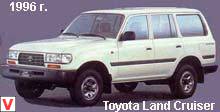
"Land Cruiser 80 - STD" perfectly proved itself in the most extreme conditions. The Toyota Land Cruiser 80 - GX was distinguished by a higher level of comfort. This model was equipped with two types of engines - a 6-cylinder 130-horsepower diesel engine of 4.2 liters or a 6-cylinder petrol unit, a working volume of 4.5 liters with a capacity of 213 horsepower. Finally, the Toyota Land Cruiser 80 - VX is a luxury car, equipped with all the options available at the time.
For this model offered the most powerful engines - gasoline injection and turbo diesel. The cars of the 80th series are three types of engines: a diesel engine 1HZ, a diesel engine with turbocharging 1HD-T with direct fuel injection and a gasoline engine 3F-E, All cars of the 80th series had a spring suspension. Almost all cars were equipped with permanent four-wheel drive, although a modification was produced with the front-wheel drive off. In August 1996, ABS (Antilock Braking System) and airbags for the driver and front passenger were included as standard equipment on all models.
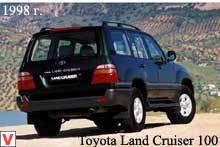
The entire experience accumulated over the years in the automotive market by Toyota was embodied in the new Land Cruiser 100 series. This model was first presented to the general public at a famous show in Chicago in January 1998, and Europe met it at an exhibition in Geneva in that same year. The Land Cruiser 100 has become larger than its predecessor - 9 centimeters longer, slightly wider, the gauge increased.
The salon has become significantly larger and more comfortable. The increase in size required and strengthening of the hull - compared to the "Land Cruiser 80" it became stronger on average by 50%. Such a significant increase in the longitudinal, diagonal and transverse rigidity is achieved through the use of steel sheets of variable profile and other reinforcing structural elements. Some of the parts that are most at risk of corrosion are covered with sheets of a special non-rusting alloy.
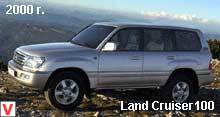
Land Cruiser 100 cars were equipped with 2 types of engines: a gasoline V-twin eight-cylinder engine 2UZ-FE with a displacement of 4.7l. developing a maximum power of 235 hp, and inline diesel six-cylinder power unit 1HD-FTE displacement of 4.2 liters. The front independent suspension on double levers and the rack and pinion steering are two more new elements of the passenger car in the new Land Cruiser series. To further enhance the comfort and stability of the management, the Skyhook TEMS system and the hydraulic clearance adjustment system (ANS) have appeared, which improve vehicle performance when driving on paved roads.
The exterior design is made in a representative style: a massive hood, large headlights with two-stage multi-reflex optical elements, a solid bumper overhanging the sides, powerful outwardly protruding wheel arches, a vast glass area and wide doors. Roof upholstery is made of nonwovens. Safety features include power steering, ABS, power brakes, airbags for the driver and front passenger, head restraints, as well as three-point seat belts with pretensioners.
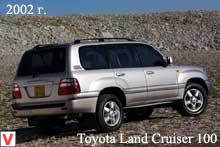
Standard equipment: central locking, electric mirrors and windows, climate control, cruise control, two auxiliary power sockets, cup holders and numerous compartments for storing various items, built-in center console, immobilizer, heat-absorbing glass with tinted steel wheels. Additional equipment: air conditioning, central locking with remote control, CD changer, alloy wheels, etc. And although the equipment of the Land Cruiser 100 is as close as possible to cars, there are still quite a few drivers using it as an SUV. For them, Toyota specialists have developed a new model of the Land Cruiser 105th series. In 2001, Toyota celebrated the 50th anniversary of the Land Cruiser.
According to the company's marketing specialists, over the years almost 4 million copies of Toyota Land Cruiser have been sold on the world market. In honor of the anniversary was released a special series of these iconic cars - "50th Anniversary". “Jubilee” copies are different from ordinary cars with chrome-plated aluminum wheel rims, a jubilee emblem on the body, leather-and-wood steering wheel, special door sills and golden-colored logos. In addition, the gear lever and the door are also trimmed with wood, and the interior is ivory-colored.
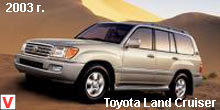
The circulation of the Land Cruiser - 50th Anniversary was very limited - for example, only 400 of these cars came to Russia. In 2007, the Land Cruiser 200 saw the light. Combining the unprecedented reliability, functionality and comfort of a premium car, the new generation of the legendary SUV continues the glorious traditions of its predecessors.
The car retained the recognizable features of the design of the family, but compared to its predecessor, the overall dimensions of the 200-ki have grown significantly - the length has increased by 60 millimeters, the width - by 30 millimeters, and the height - by 15 millimeters. The new grille, new headlights and elements of body panels even more than before, enhance the effect of massiveness and reliability of the car. At the core of the Land Cruiser 200 is the Lexus LX 570 SUV platform, which was first unveiled at a New York auto show. Salon Toyota Land Cruiser 200 - the standard of luxury and comfort.
Rich leather and wood trim, four-zone climate control, Bluetooth navigation system, premium audio system, rain sensors, built-in immobilizer, 14 airbags - all in the list of standard equipment! Every detail of the interior is designed to provide the maximum level of comfort that meets the highest expectations of Toyota customers. There is one complete set for the Russian market - “Lux”. Among its features are unique 17-inch alloy wheels, automatic switching on of headlights on command of the light sensor, an intelligent system of landing in the car and starting the engine, leather-trimmed steering wheel with remote control buttons.
An important detail of the interior is high-quality leather. The first two rows of seats are equipped with heating, and the front seats are equipped with electric adjustment and a memory system for the driver's seat. Land Cruiser 200 is equipped with the best in its class four-zone air conditioner with dust-proof filters. The display of the navigation system can display an image from the parking assistance camera. There is also a Bluetooth ™ communication system with a hands-free headset. The technical content of the car is fully consistent with the brutal appearance.
Land Cruiser 200, as befits a real SUV, has a frame structure of the body and dependent rear suspension. However, compared with the previous model, body rigidity significantly increased. The front suspension is now offered only independent, and on the springs (and not torsion, as before). Land Cruiser received a new Crawl Control system that distributes torque and braking force between the wheels while driving on loose sand, heavy mud or deep snow. The Crawl Control system automatically adjusts engine power and brakes, maintaining the set speed.
Such a system, according to representatives of the Japanese company, should greatly facilitate the work of the driver in difficult road conditions and allow him to focus on the steering. In addition, the novelty received the Multi-terrain ABS system, which independently determines which vehicle the vehicle is moving in, and, in accordance with this, establishes the desired mode of operation of the anti-lock braking system. Two new engines are offered for the novelty, the main of which will be a 288-horsepower eight-cylinder gasoline engine of 4.7 liters, which is aggregated with a five-speed automatic transmission.
The engine has been completely redesigned in accordance with modern requirements. An electronic variable valve timing system (VVT-i) has been added to it. It was also equipped with an intake system with variable geometry, which allows for increased thrust at low revs and acceleration at high revs.
Acceleration from 0 to 100 km / h takes 9.2 seconds, the maximum speed is 200 km / h. The V8 gasoline engine meets Euro 4 standards. The second engine is a 4.5-liter 235 horsepower turbo diesel engine, paired with a six-speed automatic. With this unit, the SUV will accelerate from zero to one hundred kilometers per hour in 8.6 seconds, and its maximum speed will be 210 kilometers per hour. Impressive traction is provided by a modern turbocharger with variable geometry, as well as a common rail fuel system. There is also a top version with a 5.7-liter engine for the American market. Both gearboxes are smooth and fuel efficient.
In addition to the sequential gear shift mode, they use AI-SHIFT technology, which selects the gear change algorithm that is most suitable for your driving style and road condition. Both gearboxes are smooth and fuel efficient. In addition to the sequential gear shift mode, they use AI-SHIFT technology, which selects the gear change algorithm that is most suitable for your driving style and road condition. Both gearboxes are smooth and fuel efficient. In addition to the sequential gear shift mode, they use AI-SHIFT technology, which selects the gear change algorithm that is most suitable for your driving style and road condition.
It is not enough for a modern prestigious SUV to have only four-wheel drive and a powerful engine, it should be equipped with a complete set of various electronic systems that help the driver in difficult moments. In addition to the usual ABS, traction control, and stabilization system, the Toyota Land Cruiser 200 has a slope assistance system (DAC), a slope assistance system (HAC). The transfer box now has a limited-slip differential (Torsen LSD) and can now distribute (if necessary) the torque between the axles (but not exceeding the 30:70 ratio) without the intervention of electronics.
